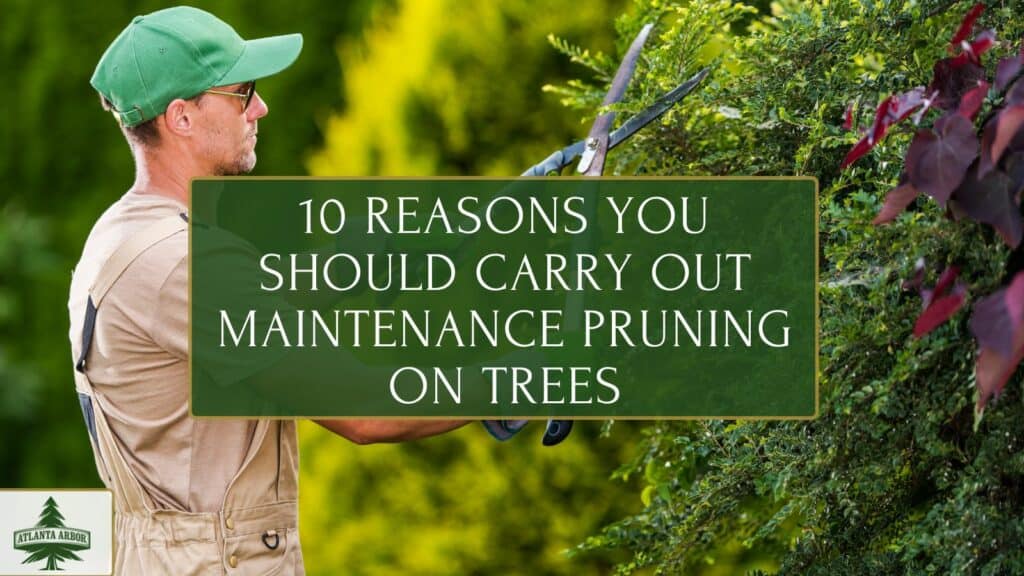Maintenance pruning is selectively removing branches to improve the tree’s health, structure, and aesthetics. Additionally, maintenance lopping involves expunging branches that rub together, suckering branches at the base of the plant, and stubbing branches.
Maintenance pruning helps to protect woody plants from pests and disease by extricating dead wood, broken branches, and diseased parts. It also ameliorates the aesthetics of trees by ejecting branches that are growing too close together, diminishing the full size or shape of a tree, and thinning out foliage to redirect energy away from overgrown areas.
10 Reasons to Carry Out maintenance Pruning on Trees
Maintenance pollarding offers numerous benefits to trees’ overall well-being and longevity in urban and natural settings. The following are ten compelling reasons why carrying out maintenance trimming on trees is essential:
1. Promotes Structural Integrity
Maintenance pruning helps develop a strong and stable tree structure by deposing weak, crossing, or competing branches. This reduces the risk of limb failure, especially during storms or heavy winds, enhancing safety for people and property.
Eliminating narrow crotch angles and including bark, pruning reduces the likelihood of branch splitting and trunk failure, augmenting the stability and longevity of trees in the landscape. Proper pruning favors a single, dominant leader, reducing the aspect ratio and improving the tree’s structural integrity
2. Enhances Tree Health
Regular maintenance paring plays reduce the risks associated with pests and diseases that negatively impact tree health. Detaching dead, diseased, or decaying branches through maintenance pruning prevents the spread of pathogens and reduces the risk of pest infestations. Promptly disconnecting these compromised branches through neatening, gardeners limit the spread of pests and diseases within the tree and throughout the landscape.
Furthermore, correct culling techniques encourage air circulation and sunlight exposure within the awning, creating an environment that is less favorable for fungal growth and insect proliferation.
Consequently, maintenance taming enhances the aesthetic appeal of trees and fortifies their natural defenses against common pests and diseases, contributing to topography health and resilience. Trees allocate resources more effectively to healthy growth and defense mechanisms by alleviating these potential entry points for disease and pests.
3. Stimulates Growth and Vigor
Pruning encourages new growth by redirecting energy to the remaining branches and promoting the development of new buds. This rejuvenation process results in denser foliage, improved flowering, and sweeping cover health.
Pruning helps maintain an optimal balance between vegetative growth and fruiting such that the tree apportions sufficient resources to both processes.
As a result, regular shearing promotes the general health and vigor of fruit trees. It accelerates the yield and quality of the harvested fruit, providing greater rewards for orchard owners and home gardeners alike.
4. Improves Air Circulation and Sunlight Penetration
Thinning the canopy through maintenance pruning allows for better air circulation and sunlight penetration into the inner branches of the tree. Increased airflow reduces the risk of fungal diseases, while adequate sunlight promotes photosynthesis and nutrient uptake.
5. Prevents Damage to Property
Overgrown branches threaten nearby structures, vehicles, and utility lines. Regular maintenance pruning helps mitigate these risks by keeping trees safe from buildings and infrastructure, reducing the likelihood of property damage and associated costs.
6. Preserves Aesthetic Appeal
Properly pruned trees contribute to the visual appeal of landscapes and urban environments. Maintenance pruning magnifies the natural shape and form of trees, creating a more pleasing and harmonious aesthetic while preserving their unique character and beauty.
7. Reduces Risk of Hazardous Situations
Untended trees with overgrown branches obstruct visibility on roads, sidewalks, and pathways, posing a hazard to pedestrians, cyclists, and motorists. By maintaining clearances and undoing hazardous limbs, maintenance pruning enhances public safety and accessibility.
8. Manages Size and Encroachment
Trees that grow too large or spread too wide encroach upon neighboring properties, causing disputes and conflicts. Regular maintenance pruning helps manage tree size and shape, preventing encroachment issues and maintaining harmonious relationships with neighbors.
9. Supports Long-Term Tree Health
Investing in maintenance pruning is a proactive measure that pays dividends in the long run. By addressing potential issues early and maintaining trees in optimal condition, property owners avoid costly emergency interventions and extend the lifespan of their trees.
10. Promotes Sustainability and Environmental Stewardship:
Healthy, well-maintained trees provide a host of environmental benefits, including carbon sequestration, air purification, and habitat creation. By practicing responsible tree care through maintenance pruning, individuals and communities contribute to preserving urban forests and ecological resilience.
How often should trees be pruned?
The frequency of tree pruning depends on the tree species, age, location, and desired outcome. On the whole, young trees require more frequent pruning to shape their growth and establish proper structure. In contrast, mature trees may need periodic maintenance pruning to displace dead or hazardous branches and maintain overall health.
When is the best time to prune trees?
The best time to prune trees depends on the species and the goals of pruning. Dormant pruning during late winter or early spring is ideal for most trees, as it minimizes stress and the risk of disease transmission. However, certain species benefit from specific pruning times to coincide with their growth patterns and flowering cycles.
What are some common mistakes to avoid when pruning trees?
Some common mistakes to avoid when pruning trees include over-pruning, making improper cuts, cutting at the wrong time of year, getting rid of too much foliage, and neglecting to consider the tree’s natural growth habits. Educating oneself on the suitable methods and seeking guidance from arborists or horticultural experts is wise to circumvent damaging trees and compromising their health.
